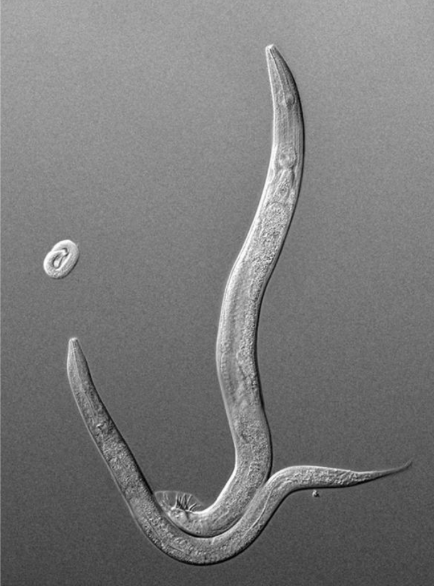How curiosity-driven research into a worm won four Nobels
(Source – The Hindu, International Edition – Page No. – 7)
| Topic: GS3 – Science and Technology |
| Context |
| ● The article explores the groundbreaking discoveries made using Caenorhabditis elegans, a model organism.
● It has helped in understanding genetic regulation, cell death, RNA interference, and gene expression. |
| Caenorhabditis Elegans: |
| ● Caenorhabditis elegans is a 1-mm long, transparent nematode commonly used in scientific research.
● It inhabits soil and feeds on microbes, making it easily cultivated in laboratories. ● The adult worm has 959 cells and 302 neurons, providing a simple model for studying development and neuroscience. ● It is widely used in genetic and developmental biology due to its straightforward anatomy and short lifespan. ● The complete genome of C. elegans has been sequenced, providing valuable insights into genetic functions. ● Its transparency allows scientists to directly observe cellular processes and track molecular activities.
|
Researches that led to Nobel Prize:
Genetic Regulation & Programmed Cell Death (2002)
- Sydney Brenner, H. Robert Horvitz, and John Sulston discovered how genes regulate organ development and programmed cell death.
- Their work revealed the genetic mechanisms that control cell death during development.
- This research is crucial for understanding diseases like cancer, where cell death regulation is disrupted.
RNA Interference (2006)
- Andrew Fire and Craig Mello discovered how double-stranded RNA silences specific genes through RNA interference.
- This mechanism prevents certain genes from producing proteins.
- Their work created powerful tools for genetic research and opened doors for therapies targeting gene expression in diseases such as cancer and genetic disorders.
Green Fluorescent Protein (2008)
- Osamu Shimomura, Martin Chalfie, and Roger Tsien developed the Green Fluorescent Protein (GFP) to track proteins in living organisms.
- GFP enabled scientists to visualize cellular processes in real time.
- Their discovery revolutionized biological research, providing a key tool to study molecular interactions within living cells.
MicroRNAs (2024)
- Victor Ambros and Gary Ruvkun discovered microRNAs (miRNAs) that regulate gene expression by silencing specific genes.
- miRNAs control various biological processes, including development and disease regulation.
- Their findings advanced our understanding of genetic regulation and opened new possibilities for diagnostic tools and therapeutic approaches in genetic diseases.
| Practice Question: Discuss the significance of Caenorhabditis elegans in advancing our understanding of genetic regulation and programmed cell death. How have its discoveries impacted medical research? (150 Words /10 marks) |
For more such UPSC related Current Affairs, Check Out –GDP growth projected to fall to four-year low at 6.4%

